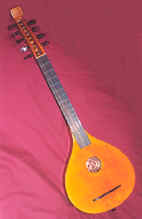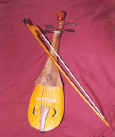
Like most Western instruments, the bagpipes originated in Arabia. They are still common throughout Europe, many countries and regions having their own particular design. The only English bagpipes still in regular use are the Northumbrian parlour pipes, powered by a belows strapped under the player's armpit, but in Medieval and Renaissance times there were numerous different designs in common use for accompanying dancers and playing around the streets. They were usually quieter, and sweeter-toned than the Scottish great pipes, which were designed as an instrument of war. King's Lynn Waites have a pair made by Norfolk bagpiper and maker Jim Parr. They are in G with a single drone, and are typical of the ordinary bagpipes of Renaissance times.

An instrument shaped like a lute, but with a flat back, and with wire strings, generally adjusted in pairs of unisons, and played with a plectrum or quill.

A melodic instrument very popular from the 10th to the 18th
centuries. The only point of resemblance to the modern cornet lies in the cup-mouthpiece,
which was, however, much shallower with a very thin edge, and made of horn, ivory or
hardwood. The body of the instrument was usually of wood (sometimes ivory) and either
straight or slightly curved. It was pierced with six holes for the fingers on the upper
side and one for the thumb on the lower. If it was a curved cornett (Ger. Krummer Zink;
Ital. cornetto curvo), the exterior of the body was planed to an octagonal shape, covered
with black leather and bound with metal ferrules.
Doubtless the curved form was derived from the shape of the
natural horn of which the Norwegian 'Bukkehorn' or 'Prillarhorn', pierced with five
finger-holes, and used by goat-herds, is a survival. The brilliancy of tone produced by a
good cornettist was much admired, both for church and secular music. For instance, Roger
North says in his Memoires (early 18th century): "Nothing comes so near or rather
imitates so much an excellent voice as a cornett pipe; but the labour of the lips is too
great and it is seldom well sounded." About the same time or a little earlier, Randle
Holme tells us, 'it is a delicate, pleasant wind musicke, if well played and humered'. The
instrument was closely associated with the sackbut.
![]()
Name given to the bassoon on its introduction into England in the 16th century and derived from the German Corthol (?Kurzholz, 'short wood'), or the French courtaud, to distinguish it from the long, straight pommers or bass shawms. Probably the 'short instruments called dulcenses' belonging to King Henry VIII were of the curtall kind, as the name dolcian or dulcino was given to the bassoon of later times. In a manuscript dated 1688, a sketch is given of a curtall which resembles a small bassoon and the author says the double curtall is '8 notes deeper than other and double the bigness'.

Information supplied by G Keith Rogers of Christopher Monk Instruments.
The tenor of the cornett family. Similar in design to the
cornett but made in a shallow 'S' shape to accommodate the extra length. This gives it the
appearance of a legless lizard.
King's Lynn Waites had two "lizarden" in the 16th century (see history page), there is a tenor cornett in Strangers Hall museum, Norwich, which it is said belonged to the Norwich Waits in 1608, and there are records of Waits in York, Exeter and other places owning lizards.

Medieval bowed string instrument, having anything from two to five strings, but usually three. It is one of the ancestors of the violin and viol families, and more specifically of the dancing master's kit or pochette. It is pear-shaped, and made from a single piece of wood, one end being carved into a peg box with a carving of a human head instead of a scroll, and the other scooped out and covered with a pine table. Grove's Dictionary 1929 says: 'It's tone was loud and harsh, emulating the female voice, according to a French poem of the 13th century. They said it, not me!

An early name for the trombone, probably derived from the Spanish sacabuche ('draw-tube'), i.e. sacar 'to draw,' and bucha 'a pipe,' originaly of boxwood (cf. Portuguese sacabuxa), the name being also given to a form of pump. In Egypt the Arabic buq is still used to denote a kind of trumpet. Other derivations, however, are from O.F. saquierboter ('to pull and to push') or Sp. sacar del buche ('to exhaust the chest'). The form first appears in Spanish literature of the 14th century, the trombone having been evolved from the trumpet about the year 1300. At the beginning of the next century the French form saqueboute is found, and at the close of the same century, when the instrument was introduced into England, it was known as the shakbusshe and subsequently as the saykebud, sackbut or sagbut.

The serpent is the natural bass of the ancient cornett family.
Made of wood bound in leather, with a brass-player's mouthpiece and finger holes like a
woodwind instrument.
It is said to have been invented by Canon Edm. Guillaume of
Auxerre in 1590 for the accompaniment of ecclesiastical plain song. Mersenne said that
"even when played by a boy it is sufficient to support the voices of twenty robust
monks".
It was an indispensable member of the primitive orchestras that
accompanied the singing in rural churches in England.
Its scale is capricious and indeed fortuitous. Because of the bends in the instrument the
fingering is inverted in the two hands (down for the left hand and up for the right). This
quaint and unscientific device and the different distances between the finger holes
indicate the great imperfection of the instrument mechanically considered, pointing to the
conclusion that a good player must have relied more on dexterity and the strength of his
embouchure rather than on the resources of the instrument itself.
A Yorkshire man of Richmond, named Hurworth, who played in the
private band of George III, could execute elaborate flute variations with perfect accuracy
on this unwieldy instrument. It continued in use well into the nineteenth century and
orchestral parts were written for it in several Mendelssohn overtures as well as some of
Beethoven's and Wagner's music. Serpent players from
around the world congregate once every two years at the Lacock
Serpentarium, hosted by Andrew Van der beek of the London Serpent Trio, for a
convivial weekend of music and fun.

A wind instrument of the oboe type, with a double reed but a
larger conical bore and a wide bell. The name is generally said to be a corruption of the
French chalumeau, but it would be more correct to say that both words have been derived
from the Latin calamus, 'a reed', through the diminutive calamellus.
As shown by an ancient fresco in the British Museum, an
instrument similar to the shawm was known to the Romans, but its popularity in Europe is
traceable to the Arabic and Saracenic influences of the12th and 13th centuries. In the
16th century shawms were made of various sizes from high treble to contra-bass.
An old proverb of the time of Henry VIII, formerly inscribed on
the walls of Leckingfield Manor House, Yorkshire, states that:
A shawme makethe a swete sounde for he
tunythe the basse:
It mountithe not to hy but kepithe rule and space:
Yet yf it be blowne withe to a vehement wynde,
It makithe it to mysgoverne oute of his kynde.

No actual examples of the medieval slide trumpet have survived, but angels were often depicted playing them, and some pieces of music specify their use, so we know what they looked like and what their range was. They consisted of a straight tube with a mouthpiece at one end and a trumpet sliding up and down on the other end. As one musicologist has pointed out, too vigorous a return to first position could easily result in the loss of the player's teeth! It was a popular instrument with early Waites, as it provided a solid bass line for a couple of shawms to elaborate on for dance music, and could also be used for fanfares and signalling. The Waite William Wylde was bought a trumpet by Lynn Town Council in 1398 for the considerable sum of One Mark (13/4d), and this was probably a slide trumpet. Ours is based on one in a 15th century painting.